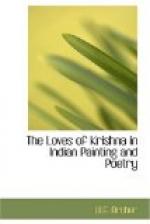Although an episode in Krishna’s later career as a prince and one designed to buttress the priestly caste of Brahmans, the story—with its emphasis on loving devotion—is actually in close accord with Krishna’s life among the cowherds. For this reason, it probably continued to excite interest long after other aspects of his courtly life had been ignored. In this respect. Sudama’s visit to Krishna is as much a parable of divine love as Krishna’s dances with the cowgirls.
[Illustration]
PLATE 20
The Beginnings of Romance
Illustration to the Gita Govinda
Garhwal. Punjab Hills, c. 1790
National Museum, New Delhi
The first poem to celebrate Radha as Krishna’s supreme love is the Gita Govinda of Jayadeva, written at the end of the twelfth century. The poem recounts Radha’s anguish at Krishna’s fickleness, his subsequent repentance and finally their passionate re-union.
The present picture with its glamorous interpretation of the forest in spring illustrates the poem’s opening verse and re-creates the setting in terms of which the drama will proceed. Nanda, the tall figure towering above the cowherd children, is commanding Radha to take Krishna home. The evening sky is dark with clouds, the wind has risen and already the flower-studded branches are swaying and bending in the breeze. Krishna is still a young boy and Radha a girl a few years older. As Radha takes him home, they loiter by the river, passion suddenly flares and they fall into each other’s arms. In this way, the verse declares, the loves of Radha and Krishna began. The left-hand side of the picture shows the two lovers embracing—the change in their attitudes being reflected in their altered heights. Krishna who originally was shorter than Radha is now the taller of the two, the change suggesting the mature character of their passionate relations.
The picture with its graceful feminine forms and twining lines has the same quality of rhythmical exaltation as Plates 19 and 35, a quality typical of the Garwhal master-artist in his greatest phase.
[Illustration]
PLATE 21
Krishna playing on the Flute
Illustration to the Gita Govinda
Kangra, Punjab Hills, c. 1790
N.C. Mehta collection, Bombay
As Radha wilts in lonely anguish, a friend describes how Krishna is behaving.
’The wife of a certain herdsman
sings as Krishna sounds a tune of love
Krishna here disports himself with charming
women given to love.’
In the picture, Radha sits beneath a flowering tree, conversing with the friend while, to the right, Krishna plays the flute to a circle of adoring girls.
The painting is by a Kangra master, perhaps Kushala, the nephew of the Guler artist, Nainsukh, and illustrates the power of Kangra painters to imbue with innocent delicacy the most intensely emotional of situations. It was the investment of passion with dignity which was one of the chief contributions of Kangra painting to Indian art.




